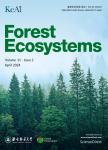Contrasting climate drivers of seasonal growth in western vs. eastern Mexican mountain conifer forests
Contrasting climate drivers of seasonal growth in western vs. eastern Mexican mountain conifer forests作者机构:Laboratorio de DendroecologiaFacultad de Ciencias Forestales y AmbientalesUniversidad Juarez del Estado de DurangoRio Papaloapan y Blvd.Durango s/n Col.Valle del SurDurango34120Mexico Instituto Pirenaico de Ecologia(IPE-CSIC)Avda.Montanana 100550192ZaragozaSpain
出 版 物:《Forest Ecosystems》 (森林生态系统(英文版))
年 卷 期:2023年第10卷第1期
页 面:64-72页
核心收录:
学科分类:0907[农学-林学] 08[工学] 0829[工学-林业工程] 09[农学]
基 金:funded by CONACYT for funding provided through project A1-S-21471
主 题:Drought Earlywood El Nino-Oscillation Latewood
摘 要:Hydroclimate affects the radial growth responses of trees, but the drivers of their spatial and population variability are not sufficiently understood. We addressed this issue by sampling several conifer populations located at the same latitude, but at different longitude and elevation in western(W) and eastern(E) Mexican regions. We used dendroecology to disentangle how earlywood width(EW), latewood width(LW) and adjusted LW(LWadj),i.e. the residuals after removing EW influences on LW, responded to climate variables(temperature and precipitation), climate indices(Southern Oscillation Index, SOI, Nino 3.4, Pacific Decadal Oscillation, PDO) and a drought index(Standardised Precipitation-Evapotranspiration Index, SPEI). The W species(Pinus herrerae Martinez, Pinus durangensis Martinez, Abies durangensis Martínez and Cupressus lusitanica Mill.) showed lower growth rates than the E species(Pinus hartwegii Lindl., Picea mexicana Martinez, Pseudotsuga menziesii(Mirb.) Franco and Abies vejari Martinez). Growth in W benefits mostly from high precipitation in the prior winter and current spring and it is limited by high temperatures in spring, whereas growth in the E showed similar but weaker ***, positive(negative) correlations were found in radial growth with the Nino 3.4(SOI) and the PDO from the prior to current autumns, which were again stronger in absolute terms in the W than in the E regions,excepting SOI in summer. In the W, P. durangensis and C. lusitanica were the least and most responsive species to spring drought, respectively;whilst P. menziesii and A. vejari were very responsive to spring drought compared to P. hartwegii in the E. Our results suggest greater responsiveness to hydroclimate and atmospheric patterns in the W than in the E region. These findings allow better interpretations of future changes in growth and composition in Mexican conifer forests, considering that climate models forecast warmer spring conditions and increased water s



